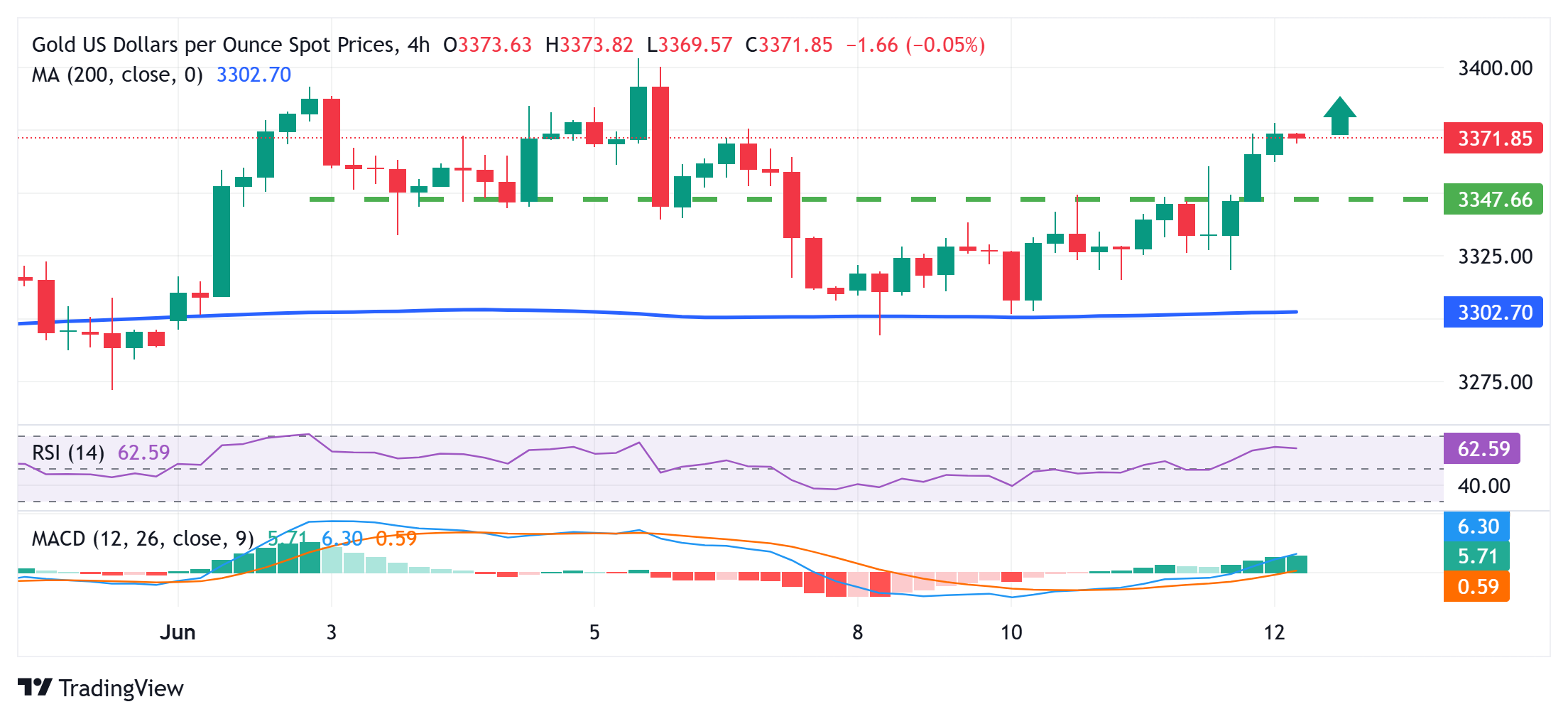- Gold price rises on safe-haven demand amid trade uncertainties and rising geopolitical tensions.
- A softer US CPI lifts Fed rate cut bets and weighs on the USD, further supporting the commodity.
- Traders now look to the US economic releases for some meaningful impetus later this Thursday.
Gold price (XAU/USD) sticks to modest intraday gains near the weekly top heading into the European session on Wednesday and remains well supported by a combination of factors. The optimism over a positive outcome from the high-stakes US-China trade talks faded in the wake of US President Donald Trump’s fresh tariff threat. Adding to this, rising geopolitical tensions weigh on investors’ sentiment, which, in turn, continues to push the safe-haven bullion higher for the second straight day.
Meanwhile, Data released on Wednesday showed that US consumer prices rose at a slower-than-anticipated pace in May, reaffirming market bets that the Federal Reserve (Fed) will resume its rate-cutting cycle in September. This leads to a further decline in the US Treasury bond yields and drags the US Dollar (USD) to the monthly low, lending additional support to the non-yielding Gold price. The XAU/USD bulls now await US macroeconomic releases before positioning for further gains.
Daily Digest Market Movers: Gold price benefits from the global flight to safety and weaker USD
- US President Donald Trump flared up trade tensions on Wednesday, saying that he would set unilateral tariff rates and inform trading partners within two weeks. This adds a layer of uncertainty and overshadows the optimism led by a positive tone following US-China trade talks in London.
- The US ordered some staff to depart its Baghdad embassy and allowed military families to voluntarily leave the Middle East amid rising security risks. This comes after Iran’s Defence Minister Aziz Nasirzadeh threatened to strike US bases in the region if conflict erupts over its nuclear program.
- Russia intensified bombardments that it said were retaliatory measures for Ukraine’s recent attacks. A new concentrated wave of drone attacks on Ukraine’s second-largest city of Kharkiv was reported early on Thursday. This keeps geopolitical risks in play and underpins the safe haven Gold price.
- On the economic data front, the US Bureau of Labor Statistics (BLS) reported on Wednesday that the headline Consumer Price Index (CPI) rose less than expected, to the 2.4% annualized pace in May from 2.3% in the previous month. The consensus estimate was for a reading of 2.5%.
- Meanwhile, the core gauge, which excludes volatile food and energy prices, matched April’s increase and climbed 2.8% during the reported month. Traders are now pricing in a 70% chance that the Federal Reserve will cut interest rates in September, dragging the US Dollar to the monthly low.
- The market focus now shifts to Thursday’s US economic docket – featuring the release of the Producer Price Index (PPI) and the usual Weekly Initial Jobless Claims data. Nevertheless, the fundamental backdrop suggests that the path of least resistance for the XAU/USD pair is to the upside.
Gold price seems poised to appreciate further and build on the momentum beyond the $3,400 mark

From a technical perspective, this week’s rebound from the 200-period Simple Moving Average (SMA) and the subsequent strength beyond $3,348-3,350 horizontal resistance favors the XAU/USD bulls. This, along with positive oscillators on daily/hourly charts, validates the near-term constructive outlook and should allow the Gold price to climb further towards reclaiming the $3,400 round figure. Some follow-through buying should pave the way for an extension of the momentum to the $3,430-3,435 region, above which the commodity could aim to retest the all-time peak, around the $3,500 psychological mark touched in April.
On the flip side, the aforementioned resistance breakpoint, around the $3,350-3.348 area, now seems to protect the immediate downside. Any further pullback could be seen as a buying opportunity near the $3.323-3,322 region. This should help limit the downside for the Gold price near the $3,300 round figure, or the 200-period SMA on the 4-hour chart. The latter should act as a pivotal point, which if broken would shift the near-term bias in favor of bearish traders.
Risk sentiment FAQs
In the world of financial jargon the two widely used terms “risk-on” and “risk off” refer to the level of risk that investors are willing to stomach during the period referenced. In a “risk-on” market, investors are optimistic about the future and more willing to buy risky assets. In a “risk-off” market investors start to ‘play it safe’ because they are worried about the future, and therefore buy less risky assets that are more certain of bringing a return, even if it is relatively modest.
Typically, during periods of “risk-on”, stock markets will rise, most commodities – except Gold – will also gain in value, since they benefit from a positive growth outlook. The currencies of nations that are heavy commodity exporters strengthen because of increased demand, and Cryptocurrencies rise. In a “risk-off” market, Bonds go up – especially major government Bonds – Gold shines, and safe-haven currencies such as the Japanese Yen, Swiss Franc and US Dollar all benefit.
The Australian Dollar (AUD), the Canadian Dollar (CAD), the New Zealand Dollar (NZD) and minor FX like the Ruble (RUB) and the South African Rand (ZAR), all tend to rise in markets that are “risk-on”. This is because the economies of these currencies are heavily reliant on commodity exports for growth, and commodities tend to rise in price during risk-on periods. This is because investors foresee greater demand for raw materials in the future due to heightened economic activity.
The major currencies that tend to rise during periods of “risk-off” are the US Dollar (USD), the Japanese Yen (JPY) and the Swiss Franc (CHF). The US Dollar, because it is the world’s reserve currency, and because in times of crisis investors buy US government debt, which is seen as safe because the largest economy in the world is unlikely to default. The Yen, from increased demand for Japanese government bonds, because a high proportion are held by domestic investors who are unlikely to dump them – even in a crisis. The Swiss Franc, because strict Swiss banking laws offer investors enhanced capital protection.

